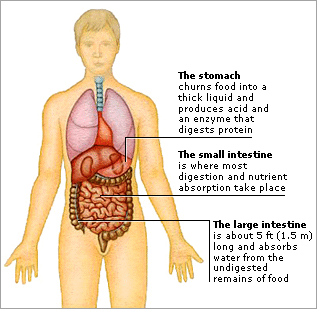DK Human Body: Digestion
- HOW DOES THE STOMACH WORK?
- WHERE DOES FOOD GO AFTER THE STOMACH?
- WHY IS THE SMALL INTESTINE SO LONG?
- HOW IS FOOD ABSORBED?
- WHY DON’T THE DIGESTIVE ORGANS DIGEST THEMSELVES?
- HOW DOES FOOD MOVE ALONG THE DIGESTIVE SYSTEM?
- WHAT HAPPENS IN THE LARGE INTESTINE?
- THE TIMETABLE OF THE DIGESTIVE SYSTEM
- ENZYMES
- FIND OUT MORE
The process of breaking down food into molecules the body can absorb is called digestion. The digestive system begins with the mouth and involves many organs in the abdomen. The digestive organs produce ENZYMES which break down food chemically.

The job of the digestive system is to turn the food we eat into material that the body can use for energy, growth, and to repair itself. It is a long system of different organs, each section working in a slightly different way to extract nutrients and water from food until only waste remains.
The stomach is a stretchy, muscular bag that stores food and churns it around until it is a thick liquid. Glands in the lining of the stomach secrete gastric juice, which contains pepsin and hydrochloric acid. Pepsin is an enzyme that digests protein molecules; hydrochloric acid kills germs and helps pepsin work.
Food is squirted from the stomach into the small intestine. Here it mixes with digestive juices from the liver and pancreas. Bile from the liver breaks up fat. Pancreatic juice neutralizes stomach acid and contains enzymes that digest carbohydrates, proteins, and fats.
The small intestine measures 21 ft (6.5 m) and is the main organ of digestion and absorption. As food moves slowly along the great length of the intestine, it has plenty of time to break down properly. The size of the small intestine also maximizes the area of inner lining that food passes and the absorbtion of nutrients.
The lining of the small intestine is covered with microscopic projections called villi which dramatically increase its surface area. Molecules of nutrients dissolve in fluids in the intestine and pass into the villi. From there, nutrients pass through the thin walls of the blood vessels in the villi, and into the body.
The lining of the stomach and intestines secretes a thick, slippery liquid called mucus, which helps food slide along and protects the digestive organs from acid and enzymes. Even so, the intestinal lining does gradually wear away, but it continually renews itself by producing new cells, just as skin does.
The esophagus, stomach, small intestine, and large intestine all have muscular walls. When these muscle walls contract, the hollow organ narrows, pushing the food forward. The contraction happens in waves that move along the organs. This action is called peristalsis.
Undigested leftovers pass into the large intestine, which absorbs water and minerals. Harmless bacteria flourish in the waste and produce some vitamins, which are also absorbed. The semisolid wastes (feces) collect in the rectum before being expelled.
An average meal takes between 18 and 30 hours to pass through the digestive system, depending on the amount and type of food. Meals rich in carbohydrates (such as sugar and starch) are digested quickest, and fatty foods take longest.
Most chemical reactions in living organisms are controlled by enzymes. There are many types, each suited to a particular task.
Enzymes are catalysts, which means that they speed up the rate of a chemical reaction. The molecules of each enzyme have a very particular shape which enables them to bind to a specific molecule in the body and make it react.
The salivary glands, stomach, pancreas, and small intestine all produce digestive enzymes. These enzymes break down proteins, carbohydrates, and fats into the units they are made up of—amino acids, sugars, and fatty acids. These tiny units are so small they can pass into the villi lining the intestine.
